Giant pumps hum inside a warehouse-like building, pushing water from the Sacramento-San Joaquin River Delta into the California Aqueduct, where it travels more than 400 miles south to the taps of over half the state’s population.
But lately the powerful motors at the Harvey O. Banks Pumping Plant have been running at reduced capacity, despite a second year of drought-busting snow and rain.
The reason: So many threatened fish have died at the plant’s intake reservoir and pumps that it has triggered federal protections and forced the state to pump less water.
The spike in fish deaths has angered environmentalists and fishing advocates, who argue the state draws too much water from the delta while failing to safeguard fish. Conversely, the reduced pumping has vexed Central Valley growers and water districts, who have complained that they need more water from the estuary and that deliveries are being unduly limited by regulatory constraints and outdated infrastructure.
Together, their criticisms have placed renewed attention on the half-century-old pumps and fish protection facilities that are critical linchpins of the State Water Project, one of the world’s largest water-delivery systems. The recent problems are also adding to the complex debate over how the state should manage water in the delta, and whether it should build a $16-billion water tunnel beneath the region.
Aggressive and impactful reporting on climate change, the environment, health and science.
The Los Angeles Times recently requested a tour of the pumping plant and its nearby fish-collecting facility to gain insights into California‘s struggle to uphold environmental protections while delivering water to the state’s cities and farmlands.
“The idea is to intercept as many fish as we can and collect them before they end up here in the pumping plant,” said Javier Miranda, a biologist and environmental program manager. “We want to save those fish, return them back out into the delta.”
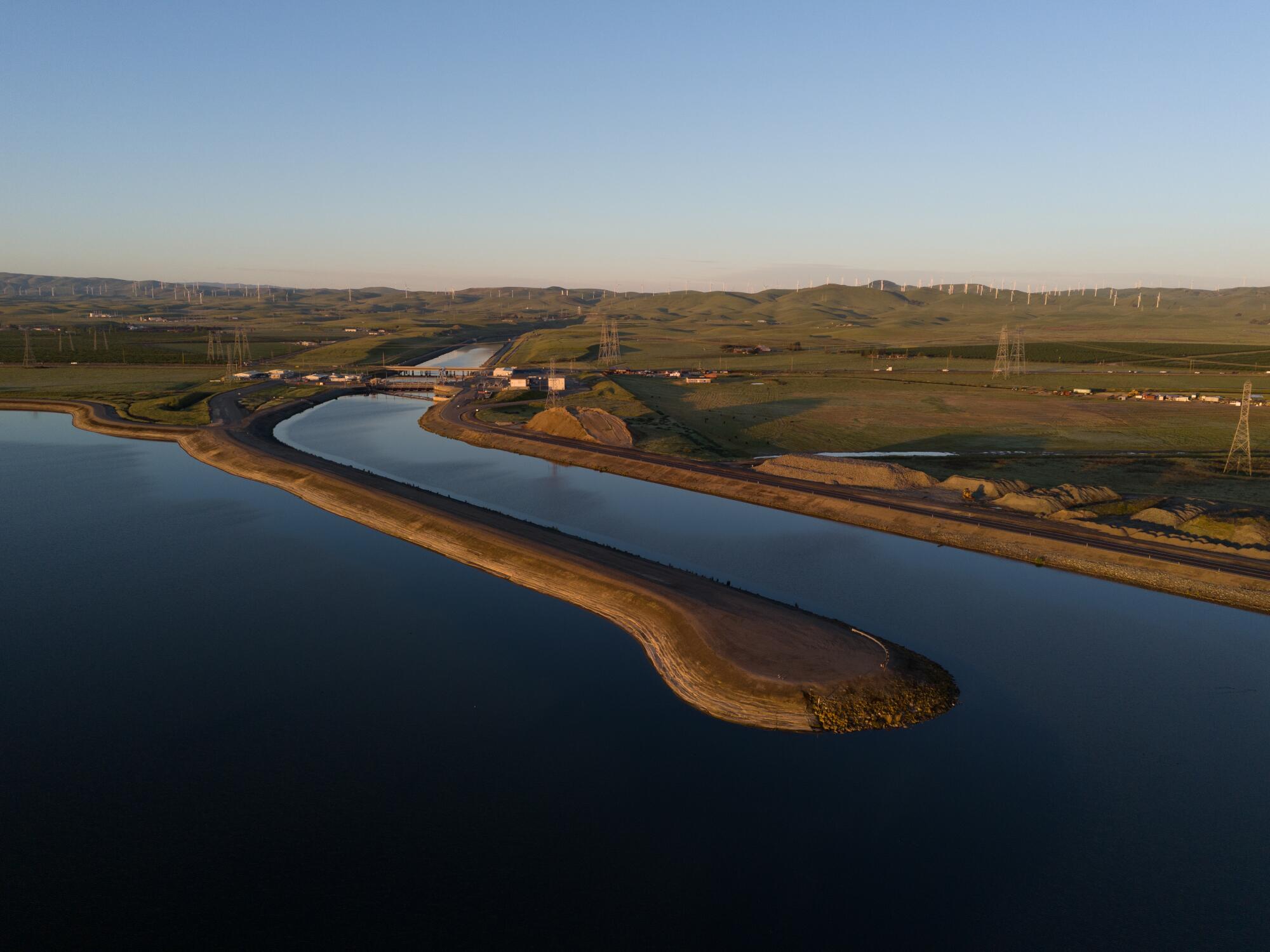
Water passes from Clifton Court Forebay through an inlet to the John E. Skinner Delta Fish Protective Facility, where fish are collected.
(Paul Kuroda/For The Times)
The state’s massive pumps, as well as nearby federal pumps that draw water into the canals of the Central Valley Project, are powerful enough that they regularly reverse the flow of water in parts of the south delta. The risk for fish is not just that they may be drawn into pump machinery and killed, but also that they will first be pulled into waters where they are easy prey for predators.
The process begins at a holding reservoir called Clifton Court Forebay, northwest of Tracy, where gates are regularly opened to allow water to flow in from the delta’s rivers and channels.
Miranda and his colleagues rode in a van to the forebay, passing green pastures where cattle were grazing among yellow blooming mustard. Two people stood with fishing poles on the banks of the shimmering reservoir, which covers nearly 2,200 acres.
Enclosed in levees, the shallow forebay is filled with nonnative striped bass and other predators, which feed on juvenile salmon, steelhead trout and other native fish.
Some experts describe the forebay as a “death trap” for fish species that have suffered major declines in recent years.
Studies have shown that about 75% of the young salmon that pass through the gates are killed by predators in the forebay, Miranda said.
For several years, he and other state scientists carried out an experimental program to capture as many nonnative fish as they could. They used methods including stunning fish with an electric current and trapping them with nets, then releasing them in another reservoir.
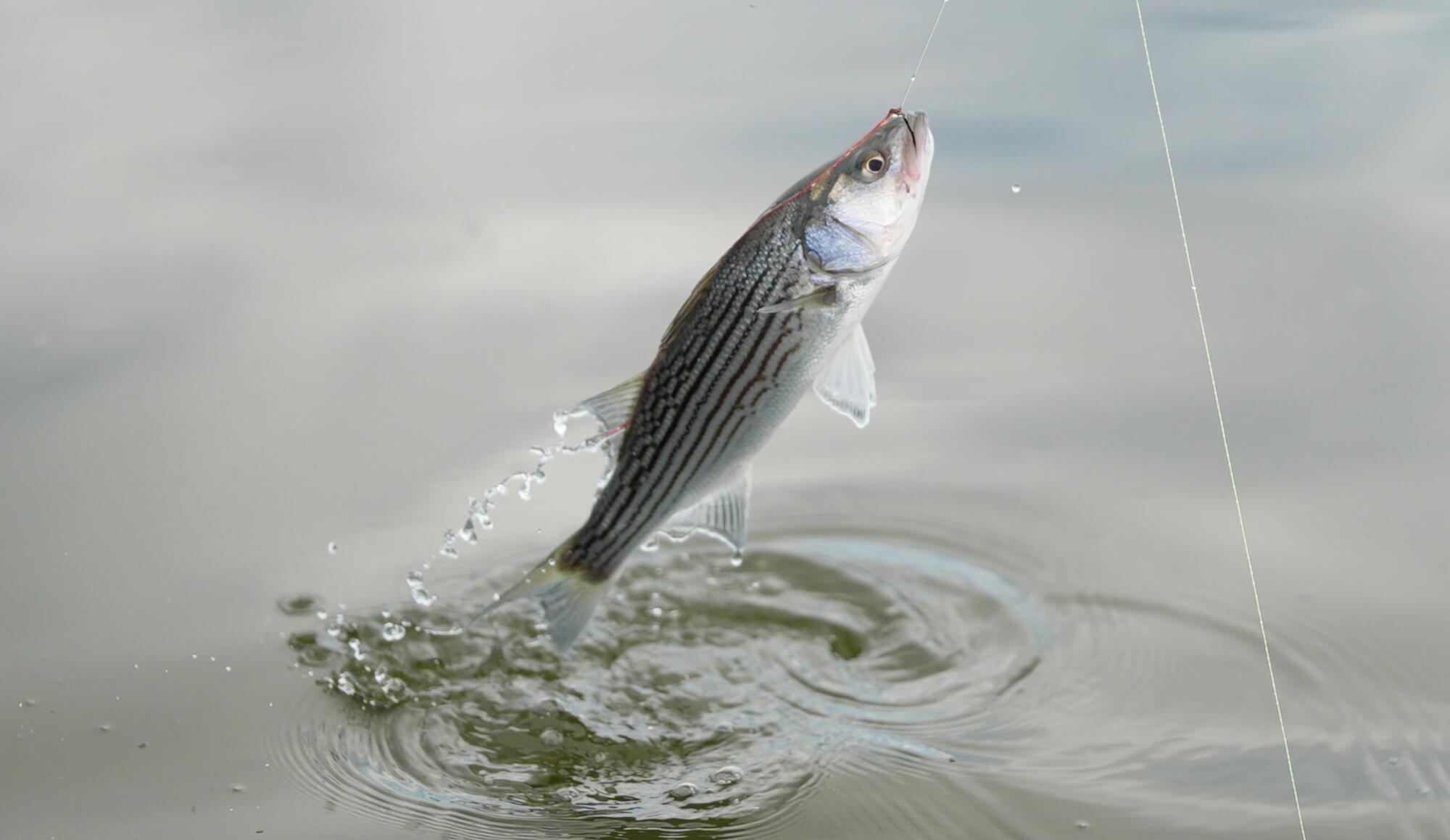
A striped bass is pulled from Clifton Court Forebay on a fishing line.
(Paul Kuroda/For The Times)
Ultimately, however, Miranda said they stopped the effort because it wasn’t improving the survival rate of salmon in the forebay.
Some environmentalists have urged the state to redesign the reservoir and erect large screens that would prevent fish from being drawn into the forebay, but state water officials say that wouldn’t solve the problems.
Those fish that manage to avoid predators in the forebay next encounter an elaborate system of underwater barriers at the John E. Skinner Delta Fish Protective Facility, which has been operating since 1968.
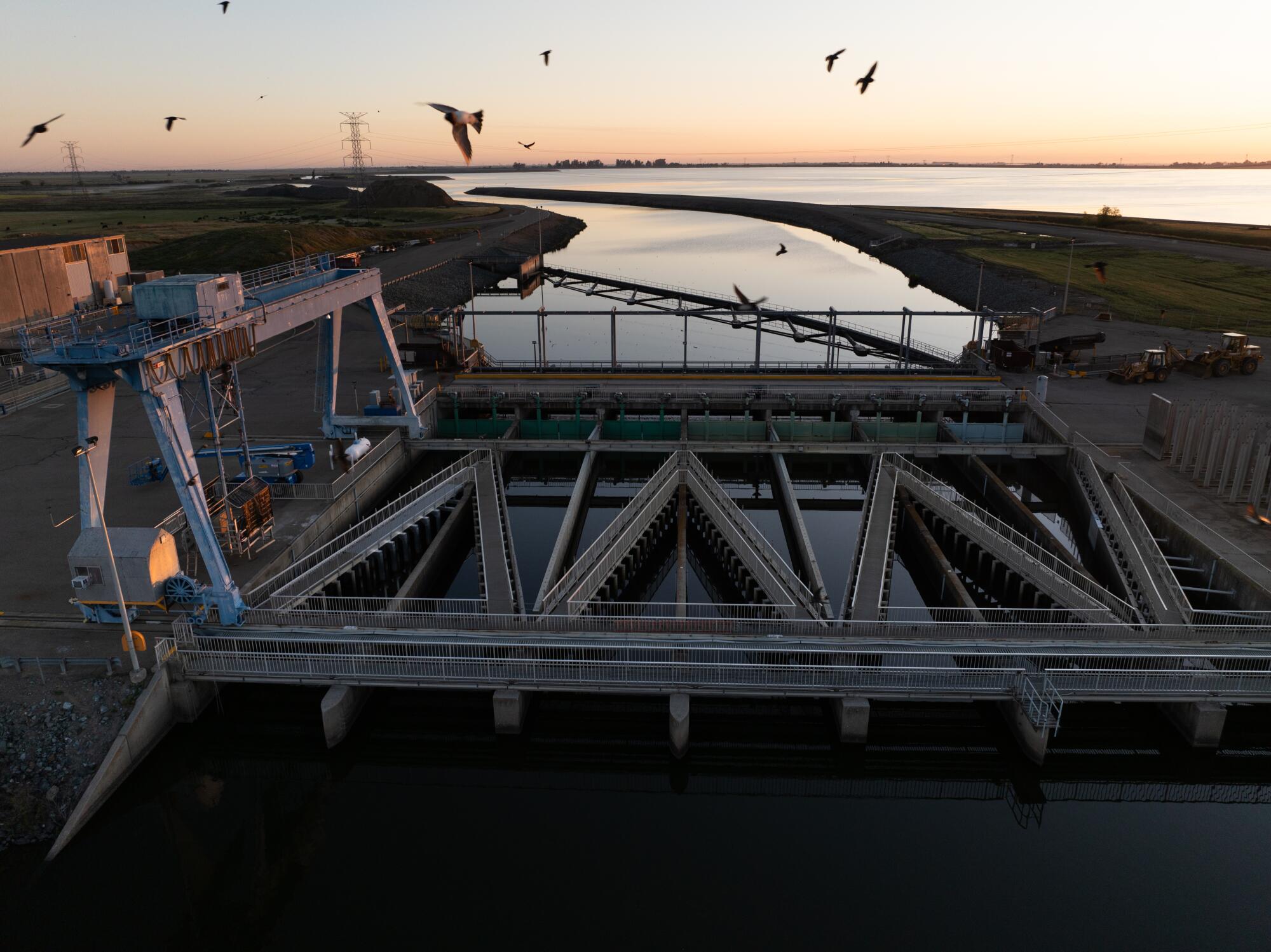
Birds fly over a structure made up of metal louvers that guides fish into the John E. Skinner Delta Fish Protective Facility.
(Paul Kuroda/For The Times)
Beside the facility, located about 2 miles from the pumps, Miranda and his colleagues stood on a bridge over the 158-foot-wide intake channel.
On one side, beside a floating boom designed to trap debris, a mechanical gripping device lifted out a tangle of aquatic weeds. The plants, which were discarded in a bin, gave off a smell of muddy decay.
On the other side of the bridge, the water flowed through a structure made up of dozens of metal panels arranged in a zigzag formation.
Each metal louver resembles a giant vertical blind or a tall fence, with the slats spaced 1 inch apart — large enough to allow large volumes of water to pass through while also functioning as a “fish guidance device.”
“This is our first point where we’re guiding fish into the facility,” Miranda said. “It’s to protect fish that would otherwise go to the pumping plant.”
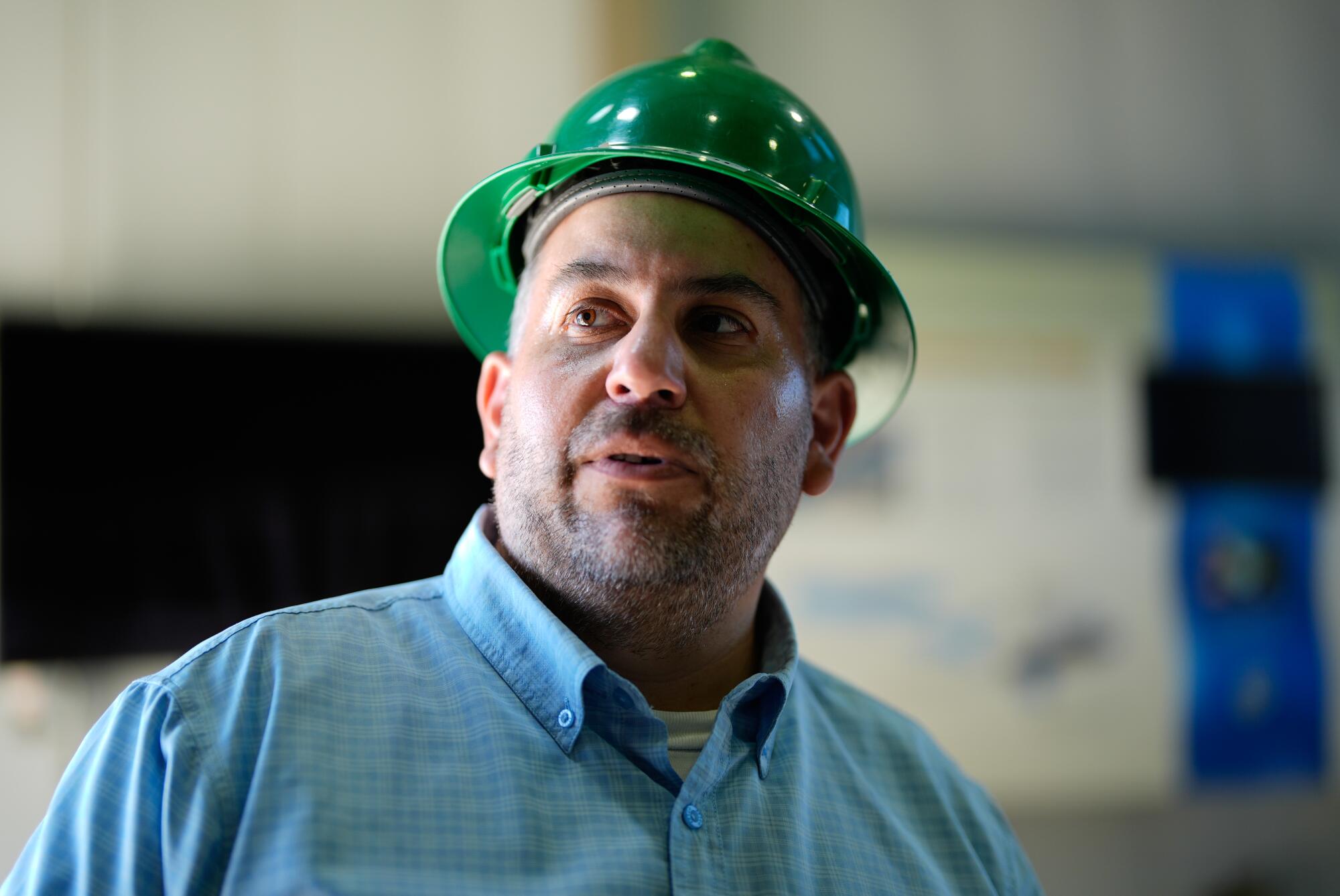
Javier Miranda, an environmental program manager in the State Water Project’s delta fisheries monitoring section, leads a tour of the John E. Skinner Delta Fish Protective Facility.
(Paul Kuroda/For The Times)
The spaces between the metal slats create ripples, and fish tend to swim away. The system funnels many of the fish toward pipes that carry them into the collection facility.
About 75% to 80% of fish that make it to this point are collected, Miranda said. “And then the remainder are what we directly lose to the pumps.”
As Miranda and others walked on a metal grate over the channel, two workers in hard hats stood on a platform spraying water to clean algae off a metal louver.
“Every single one of these is lifted and cleaned every week,” said Trent Schaffer, the acting civil maintenance branch manager. “The cleaner they are, the more efficient the flow through the facility is.”
The captured fish pass through four large pipes, then enter other channels with louvers and screens, and finally travel through smaller pipes into the building, where they end up in 20-foot-wide concrete tanks.
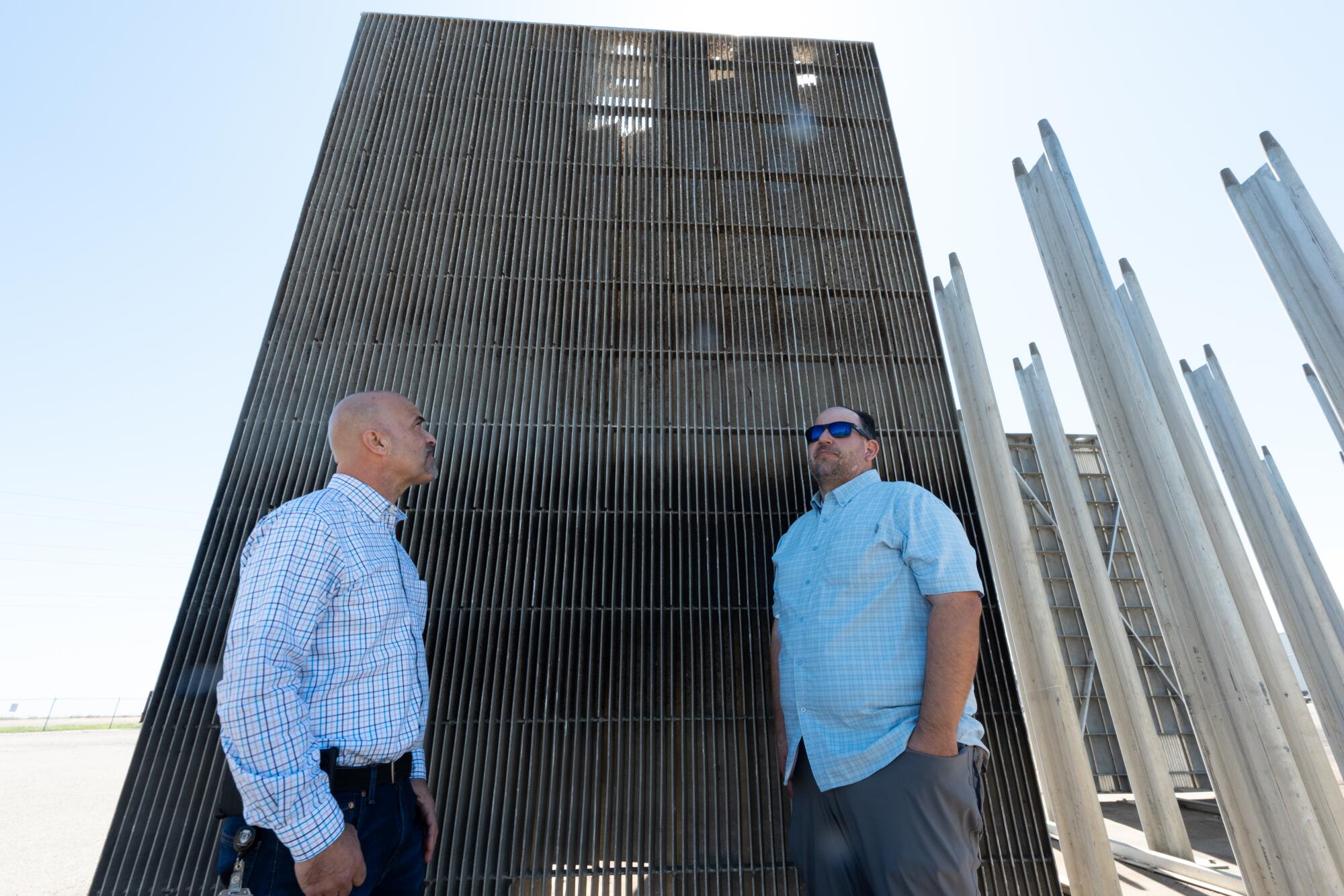
Trent Schaffer, acting civil maintenance branch manager, and Javier Miranda, an environmental program manager, stand in front of a spare metal louver. The 13-foot-tall panel is one of dozens placed underwater to guide fish into the John E. Skinner Delta Fish Protective Facility.
(Paul Kuroda/For The Times)
Biologists have found that nearly all the fish that arrive in the building live through the process.
“Once they get in here, it’s very high survival,” Miranda said.
The fish that are collected are regularly transferred to a truck with an oxygenated tank and hauled to one of several locations in the delta to be released. Before that occurs, however, the facility operators will collect a sample of the fish from one of the concrete tanks, and use it to estimate the total number that are “salvaged.”
“It’s impossible for us to count all of the fish,” Schaffer said.
Based on the number of fish collected, the employees estimate how many are killed by predators in the forebay or sucked into the pumps. These estimates are tracked against limits in the facility’s permits under endangered species laws.
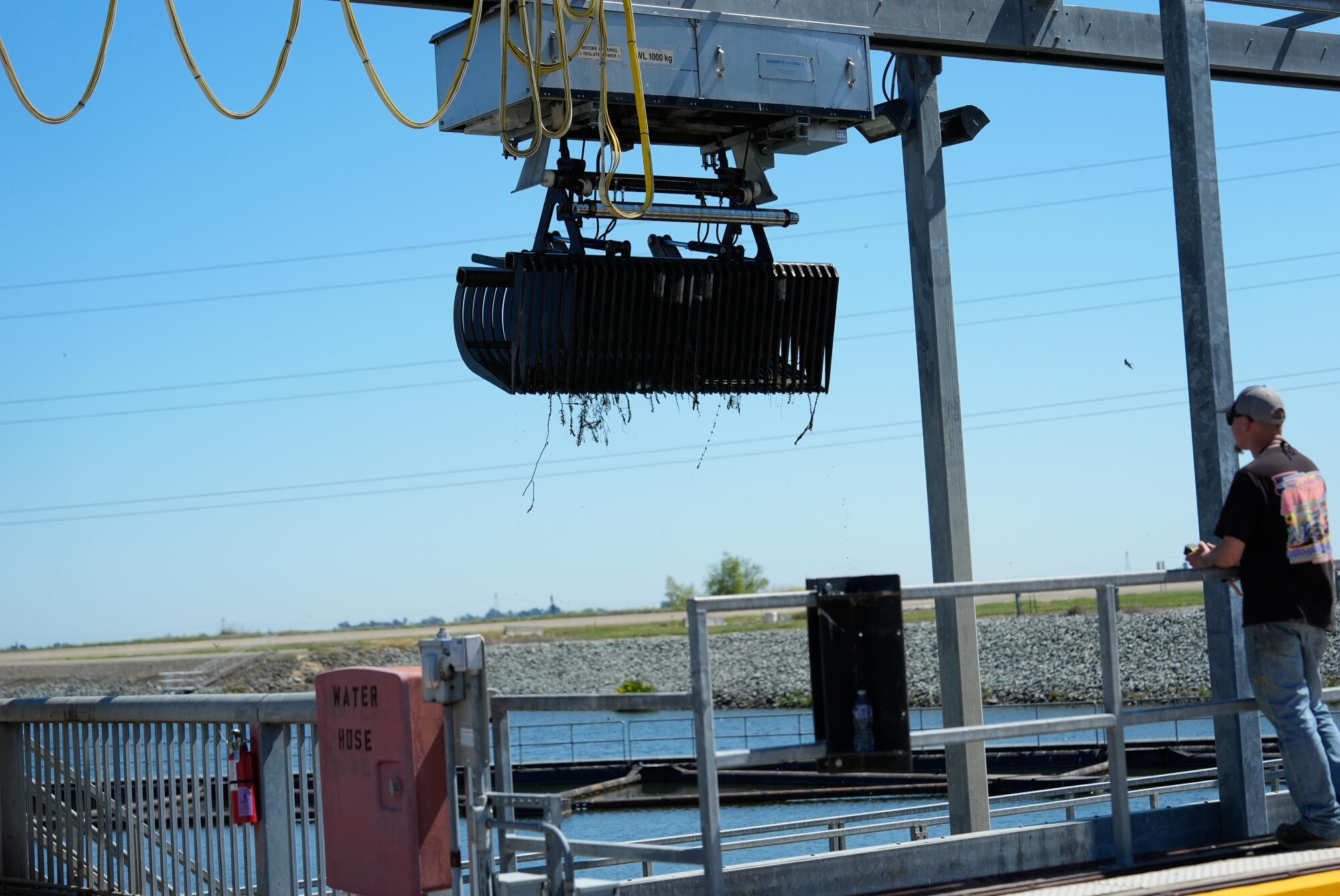
An employee uses a claw-like device to remove aquatic plants from the channel at the John E. Skinner Delta Fish Protective Facility.
(Paul Kuroda/For The Times)
During the tour of the Skinner facility, the pumping plant was not running, so there were no fish in the collection tanks. However, the staff demonstrated how they collect a sample.
First, a 90-gallon steel bucket with sieve-like perforations was lowered into one of the tanks on a cable. When it was lifted, water rushed out forcefully, filling the building with a crashing sound and causing metal railings to vibrate as a whirlpool formed in the bottom of the tank.
Next, the bucket slid into position above a vat resembling a large cooking pot, and emptied its payload. In this vat, workers will count, identify and measure each fish by hand.
Last month, environmental groups called for state and federal agencies to reduce pumping after the estimated losses of steelhead trout and winter-run Chinook salmon exceeded maximum annual limits.
Managers of the facility said they’ve limited pumping in recent months after steelhead and salmon moved into the area, and have further cut water exports to minimal levels in recent weeks because of flow requirements for another species, longfin smelt.
At other times, pumping has been reduced to avoid harming endangered delta smelt, which are on the brink of extinction.
The methods of collecting fish have largely remained the same since the facility was built. But the system was enlarged in 1986, when the number of pumps was increased from seven to 11.
At full capacity, the pumping plant now consumes as much power as 211,000 homes. It pushes water 244 feet uphill and can send a river pouring into the aqueduct at a rate of up to 10,870 cubic feet per second. The water flows to farmland in the San Joaquin Valley and cities across Southern California.
Miranda and other state officials acknowledge that there are significant shortcomings in the existing facilities, such as the forebay filled with predators, but say they are making improvements in operations. They also tout the infrastructure’s effectiveness at directing most fish away from the pumps and keeping the water flowing.

A poster shows fish species that are collected at the Skinner fish facility near Byron.
(Paul Kuroda/For The Times)
To prevent migrating fish from entering the south delta, the Department of Water Resources installed a fence-like system that creates a barrier of bubbles at the junction of the Sacramento River and Georgiana Slough in the north delta. Along with the bubbles, the system emits flashing lights and pulsating sounds that encourage fish to keep moving down the Sacramento River toward San Francisco Bay, away from the interior delta and the zone of the pumps.
Some managers call this the “disco barrier.” They say it’s proving to be effective.
The department has also sought to improve the operation at the fish-collection facility by incorporating genetic testing technologies to more accurately differentiate between endangered and non-endangered types of salmon.
Despite these efforts, managers of the State Water Project have so far limited this year’s allocation to 40% of suppliers’ full allotments — the same level that federal officials have set for agricultural water districts south of the delta.
The restrictions on pumping have demonstrated the challenges the state faces with the existing infrastructure and the location of the pumps, said Karla Nemeth, director of the Department of Water Resources.
“It’s limiting the movement of water in a period where we should be focused on moving more so that we’re better prepared for a dry year,” Nemeth said.
She said that’s one of the reasons Gov. Gavin Newsom has proposed building the Delta Conveyance Project, a 45-mile tunnel that would transport Sacramento River water beneath the delta and create a second delivery route.
Newsom has said the project is critically important for the state to adapt to the effects of climate change.
Officials at the Department of Water Resources say building the tunnel would enable the state to capture more water during wet periods while limiting harm to fish and reducing reliance on supplies from the “conflict zone” in the south delta. Upgrades to existing facilities won’t address the problems, they say.
Plans for the tunnel have generated bitter controversy and sparked lawsuits.
One of those criticizing the state’s approach in the delta is Chris Shutes, executive director of the California Sportfishing Protection Alliance. He has argued that building the tunnel would cause more problems for fish and the ecosystem.
“They should be looking at improving the existing facilities,” Shutes said.
For more than a decade, his group has urged the state to upgrade its infrastructure by installing fish screens at the entrance to Clifton Court Forebay that would keep many fish out and reduce losses to predators.
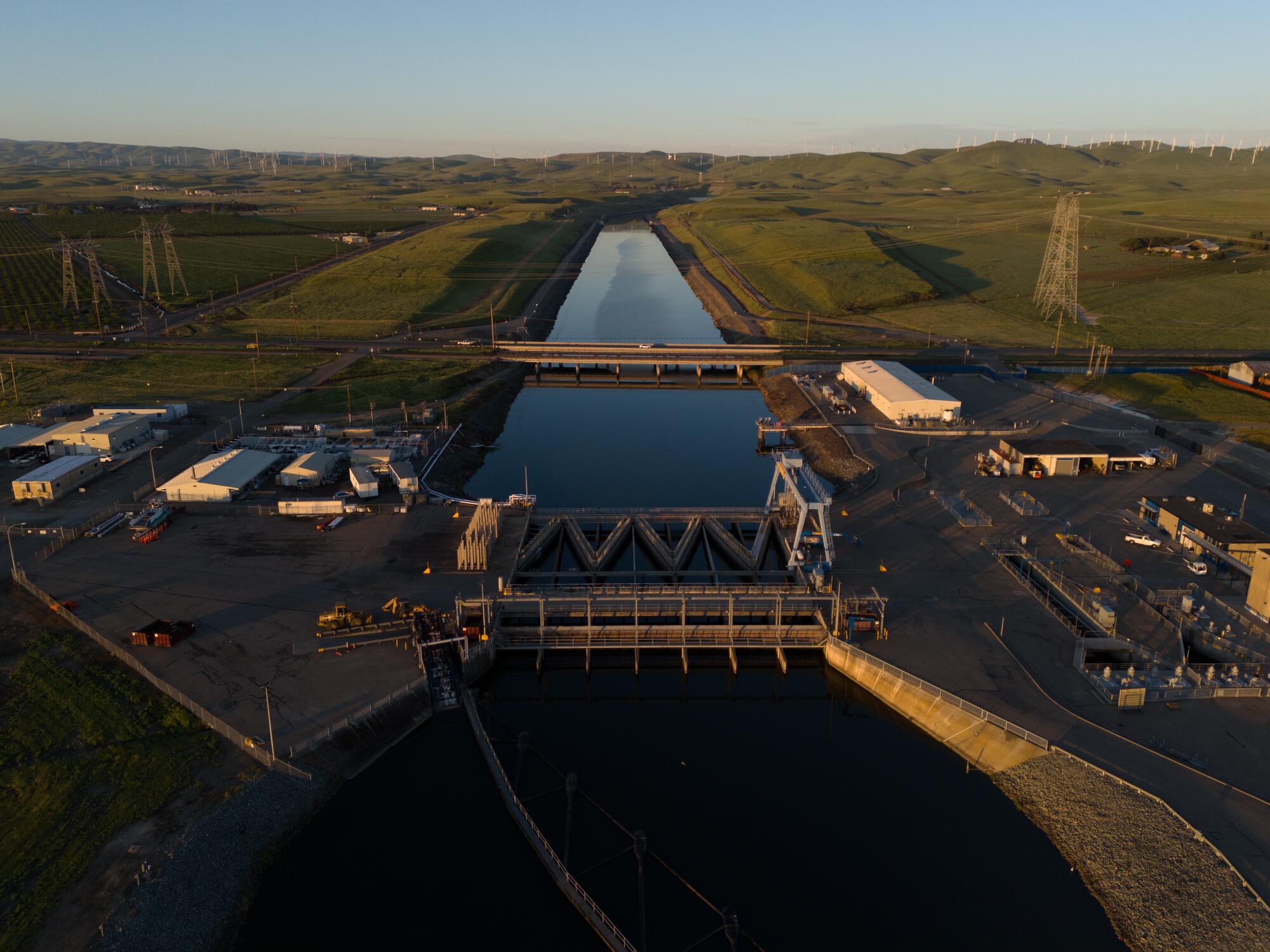
The Skinner fish facility is located 2 miles from the pumping plant that sends water into the California Aqueduct.
(Paul Kuroda/For The Times)
The screens would need to be much larger than the existing louvers at the fish facility, and redesigning the system would be costly. But Shutes said this sort of upgrade, along with changes in pumping procedures, would lessen the toll on fish.
If that isn’t done, he said, “we’ll continue to have large amounts of fish mortality at the intakes.”
Along with the disagreements over how to modernize infrastructure, there is ongoing debate about how state regulators should manage water in the delta.
The State Water Resources Control Board is considering new water quality standards that will determine how much water may be diverted and pumped, and how much should be allowed to flow through the delta. As part of this process, the Newsom administration has proposed negotiated “voluntary agreements” between the state and water suppliers, while environmental groups have urged the board to adopt traditional regulatory requirements, which they argue would help struggling fish populations.
At the same time, some experts say state officials should continue examining ways of improving the existing infrastructure to better protect fish.
Exactly how that might be done remains a dilemma, said Greg Gartrell, an engineer and former manager of the Contra Costa Water District. While there have been proposals to install new fish screens or move the intake to another location, he said, the conditions in much of the south delta make it an “unfriendly place” for native fish, where many are lost to nonnative predators such as bass.
“It’s a very, very difficult situation to resolve,” Gartrell said.





